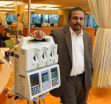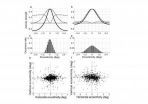(Press-News.org) Fairbanks, Alaska—University of Alaska Fairbanks scientists have identified what they think is the ancestral trait that allowed for the evolution of air breathing in vertebrates. They will present their research at the 42nd annual meeting of the Society for Neuroscience Oct. 17 in New Orleans.
"To breathe air with a lung you need more than a lung, you need neural circuitry that is sensitive to carbon dioxide," said Michael Harris, a UAF neuroscientist and lead researcher on a project investigating the mechanisms that generate and control breathing.
"It's the neural circuitry that allows air-breathing organisms to take in oxygen, which cells need to convert food into energy, and expel the waste carbon dioxide resulting from that process," he said. "I'm interested in where that carbon-dioxide-sensitive neural circuit, called a rhythm generator, came from."
Harris and colleagues think that air breathing likely evolved in an ancestral vertebrate that did not have a lung, but did have a rhythm generator.
"We try to find living examples of primitive non-air-breathing ancestors, like lamprey, and then look for evidence of a rhythm generator that did something other than air breathing," Harris said.
Lampreys are ancient fish that have characteristics similar to the first vertebrates. They do not have lungs and do not breathe air. As larvae, they live in tubes dug into soft mud and breathe and feed by pumping water through their bodies. When mud or debris clogs a lamprey's tube, they use a cough-like behavior to expel water and clear the tube. A rhythm generator in their brain controls that behavior.
The video clip below recorded in Harris' lab shows the difference between gill ventilation and a 'cough' in a larval lamprey. The 'cough' occurs at about the 9 second mark.
http://bit.ly/IAB_Harris_lamprey
"We thought the lamprey 'cough' closely resembled air breathing in amphibians," said Harris. "When we removed the brains from lampreys and measured nerve activity that would normally be associated with breathing, we found patterns that resemble breathing and found that the rhythm generator was sensitive to carbon dioxide."
Air breathing evolved in fish and allowed the movement of vertebrates to land and the evolution of reptiles, birds and mammals. Without a carbon-dioxide-sensitive rhythm generator, the structure that would become the lung might not have worked as a lung.
"The evolution of lung breathing may be a repurposing of carbon dioxide sensitive cough that already existed in lungless vertebrates, like the lamprey," said Harris.
###
Harris and collaborators Barbara Taylor, a UAF neuroscientist, and their lab technician Megan Hoffman, also study Sudden Infant Death Syndrome and hope understanding the evolutionary origin of breathing will provide insights into their SIDS research.
ADDITIONAL CONTACTS:
Michael Harris, associate professor of integrative physiology and neuroscience, 907-474-7801, mbharris@alaska.edu.
Barbara Taylor, associate professor of biology in neuroscience, 907-474-2487, betaylor@alaska.edu.
Megan Hoffman, research technician, 907-474-5024, mhoffman2@alaska.edu
ON THE WEB: Society for Neuroscience annual meeting: http://www.sfn.org/am2012/
Institute of Arctic Biology: www.iab.uaf.edu
NOTE TO EDITORS: Michael Harris and Megan Hoffman are attending the Society for Neuroscience meeting in New Orleans. Harris is available via text message at 907-590-7515.
Scientists identify likely origins of vertebrate air breathing
2012-10-17
ELSE PRESS RELEASES FROM THIS DATE:
Targeting cancers' 'addiction' to cell-cycle proteins shuts down tumors in mice
2012-10-17
BOSTON—In what they say is a promising and highly selective treatment strategy, scientists at Dana-Farber Cancer Institute have safely shut down breast cancer and a form of leukemia in mice by targeting abnormal proteins to which the cancers are "addicted," according to a new study.
Even though the investigators genetically silenced the proteins or blocked them with a drug in normal as well as cancerous tissues, the animals remained healthy, they report in the Oct. 16 issue of the journal Cancer Cell. Peter Sicinski, MD, PhD, of Dana-Farber is the paper's senior author.
The ...
Scientists to EPA: Include women in reproductive health research
2012-10-17
CHICAGO --- A team of Northwestern University scientists will meet with Environmental Protection Agency (EPA) administrators in Washington D.C. Oct. 18 to advocate for important changes in the agency's guidelines for reproductive health research.
"The problem is current research assessing the risk of toxins on reproductive health is not being uniformly investigated in both sexes and across the lifespan," said Kate Timmerman, program director of the Oncofertility Consortium of Northwestern University, who will be one of the scientists meeting with the EPA. The reproductive ...
Political empowerment fading for black Americans in the 'Age of Obama'
2012-10-17
Hailed by some as the "end of race as we know it" and the beginning of a "post-racial" America, the 2008 election of Barack Obama sparked a measurable bump in feelings of political empowerment among black Americans.
But those sentiments have faded considerably over the last year or so, according to a new analysis of political survey data, with the sharpest declines in perceived political power coming among blacks who identify themselves as conservatives or "born again" Christians.
"The election of a black American to the U.S. presidency did seem to empower African Americans, ...
Obese teen boys have up to 50 percent less testosterone than lean boys, UB study finds
2012-10-17
BUFFALO, N.Y. -- A study by the University at Buffalo shows for the first time that obese males ages 14 to 20 have up to 50 percent less total testosterone than do normal males of the same age, significantly increasing their potential to be impotent and infertile as adults.
The paper was published online as an accepted article in Clinical Endocrinology.
The authors are the same researchers in the University at Buffalo's School of Medicine and Biomedical Sciences who first reported in 2004 the presence of low testosterone levels, known as hypogonadism, in obese, type ...
Common birth control device may be cost-effective treatment for early endometrial cancer
2012-10-17
AUGUSTA, Ga. – A common birth control device is effective in treating early-stage endometrial cancer in morbidly obese and high-risk surgery patients, said Georgia Health Sciences University Cancer Center researchers, and could lead to a cost-effective treatment for all women with this cancer type.
Endometrial cancer, which starts in the lining of the uterus, is the third most common gynecologic cancer, striking more than 47,000 American women every year, particularly the obese. "Total hysterectomy, sometimes with removal of lymph nodes, is the most common treatment ...
Abnormal involuntary eye movements in amblyopia linked to changes in subcortical regions of brain
2012-10-17
Amsterdam, NL, October 16, 2012 – Little is known about oculomotor function in amblyopia, or "lazy eye," despite the special role of eye movements in vision. A group of scientists has discovered that abnormal visual processing and circuitry in the brain have an impact on fixational saccades (FSs), involuntary eye movements that occur during fixation and are important for the maintenance of vision. The results, which raise the question of whether the alterations in FS are the cause or the effect of amblyopia and have implications for amblyopia treatment, are available ...
Viral alliances overcoming plant defenses
2012-10-17
PULLMAN, Wash.— Washington State University researchers have found that viruses will join forces to overcome a plant's defenses and cause more severe infections.
"These findings have important implications in our ability to control these viruses", says Hanu Pappu, Sam Smith Distinguished Professor of Plant Virology and chair of WSU's Department of Plant Pathology. "Mixed infections are quite common in the field and now we know that viruses in these mixed infections are helping each other at the genetic level to overcome host defenses and possibly lead to the generation ...
New paper reveals fundamental chemistry of plasma/liquid interactions
2012-10-17
Though not often considered beyond the plasma television, small-scale microplasmas have great utility in a wide variety of applications. Recently, new developments have begun to capitalize on how these microplasmas interact with liquids in applications ranging from killing bacteria for sterilizing a surface to rapidly synthesizing nanoparticles.
An interdisciplinary collaboration between researchers at Case Western Reserve University and the University of Notre Dame has revealed a critical interaction that is occurring at this plasma-liquid interface in that the electrons ...
Immune response may link social rejection to later health outcomes
2012-10-17
No matter which way you look at it, rejection hurts. Experiencing rejection from a boss, a friend, or a partner is difficult enough for many adults to handle. But adolescents, who are dealing with the one-two punch of biological and social change, may be the most vulnerable to its negative effects.
In a new study published in Clinical Psychological Science, a journal of the Association for Psychological Science, researcher Michael Murphy and colleagues examine the human immune response as a potential link between social stressors like rejection and later mental and physical ...
Jelly-like atmospheric particles resist chemical aging
2012-10-17
Cambridge, Mass. - October 16, 2012 - Atmospheric chemists at the Harvard School of Engineering and Applied Sciences (SEAS) have found that when it comes to secondary organic material in the atmosphere, there are two distinct breeds: liquids and jellies.
Secondary organic materials (SOM) are airborne particles that have begun to react with gases in the atmosphere. In the last 20 years' research and climate modeling, these SOM particles have been assumed to drift as liquids. In a liquid phase, the organic materials would absorb other compounds like ammonia or ozone very ...




